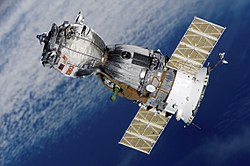| COSPAR ID | 1987-013A |
|---|---|
| SATCAT no. | 17482 |
| Mission duration | 174 days, 3 hours, 25 minutes, 56 seconds |
| Orbits completed | ~2,810 |
| Spacecraft properties | |
| Spacecraft | Soyuz 7K-STM No. 52 |
| Spacecraft type | Soyuz-TM |
| Manufacturer | NPO Energia |
| Launch mass | 7,100 kilograms (15,700 lb) |
| Crew | |
| Crew size | 2 up 3 down |
| Members | Aleksandr Laveykin |
| Launching | Yuri Romanenko |
| Landing | Aleksandr Viktorenko Muhammed Faris |
| Callsign | Taimyr |
| Start of mission | |
| Launch date | 5 February 1987, 21:38:16 UTC [1] |
| Rocket | Soyuz-U2 |
| Launch site | Baikonur 1/5 |
| End of mission | |
| Landing date | 30 July 1987, 01:04:12 UTC [2] |
| Landing site | 80 kilometres (50 mi) from Arkalyk |
| Orbital parameters | |
| Reference system | Geocentric |
| Regime | Low Earth |
| Perigee altitude | 341 kilometres (212 mi) |
| Apogee altitude | 365 kilometres (227 mi) |
| Inclination | 51.6 degrees |
| Period | 91.6 minutes |
| Docking with Mir [3] | |
| Docking date | 7 February 1987, 23:27:40 UTC |
| Undocking date | 29 July 1987, 20:44:00 UTC |
 Soyuz programme (Crewed missions) | |
Soyuz TM-2 was a crewed spaceflight to the Soviet space station Mir, which was uncrewed at the time. TM-2 was launched on February 5, 1987, and it was first crewed spaceflight of the Soyuz-TM spacecraft, [4] and the second crewed spaceflight to Mir (the first being Soyuz T-15). The crew of the long duration expedition, Mir EO-2, who were launched by TM-2 consisted of Soviet cosmonauts Yuri Romanenko and Aleksandr Laveykin.
Contents
The spacecraft remained docked to Mir, functioning as a lifeboat for the EO-2 crew, until July 1987 when it returned to Earth carrying Laveykin and the two man crew of Mir EP-1. Romanenko later returned to Earth in Soyuz TM-3 at the end of EO-2.

